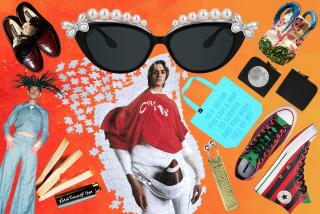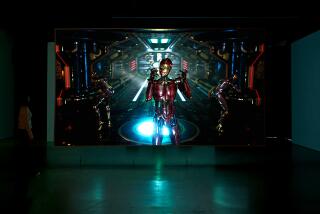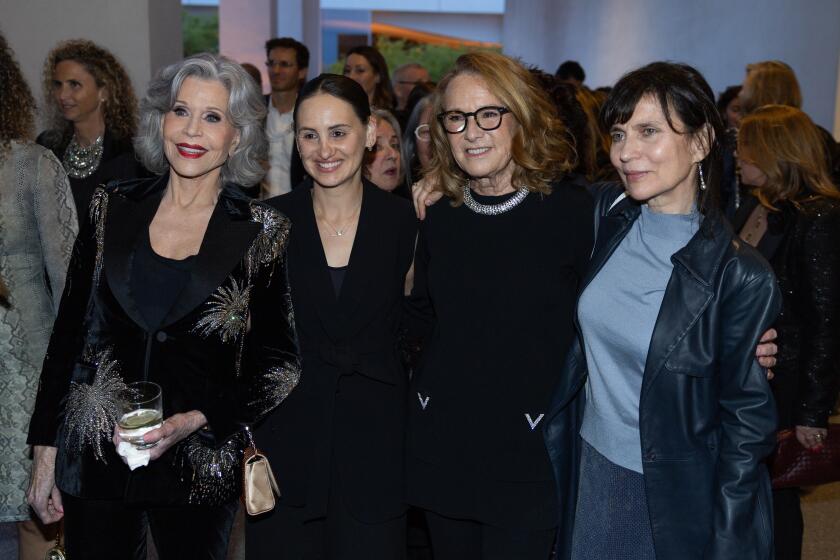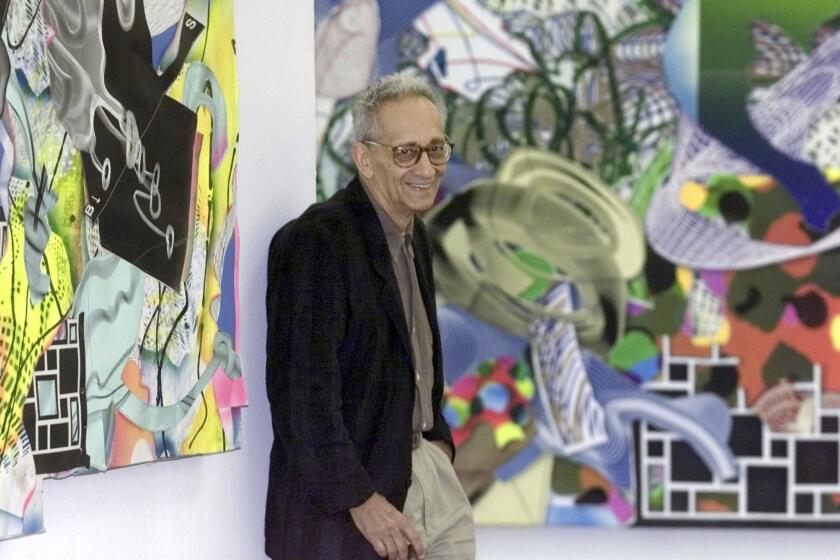For artist Marie Rim, burkas a fitting way to spark dialogue
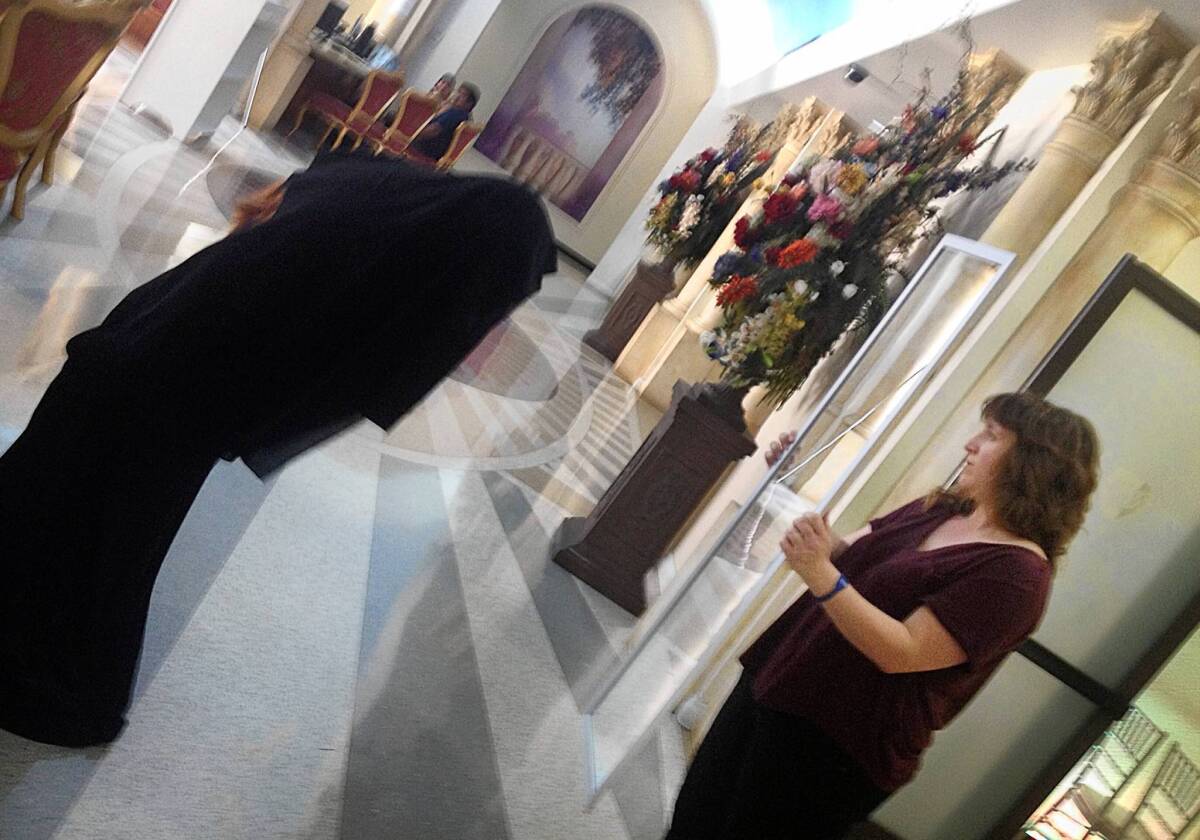
Downtown Los Angeles has seen its share of pop-up art galleries and restaurants. On a recent afternoon, it saw its first pop-up burka fitting.
“Excuse me, ma’am, I’m working on an art project,” said Marie Rim, a soft-spoken 33-year-old artist from Philadelphia. She went table to table at Grand Central Market carrying a flimsy, full-length mirror from Target under one arm and a hand-painted, black-and-yellow sign in the other: “Burka Fitting. See How It Feels to Wear One. All Welcome.”
Rim smiled at one woman shyly but hopefully, awkwardly repositioning the bulky items in her arms. “It will only take two minutes,” she said.
PHOTOS: Arts and Culture by The Times
The middle-aged woman, hunched over a half-eaten sandwich, slid her sunglasses down her nose, furrowed her brow and shook her head no.
That was the typical reaction on this particular afternoon, but Rim’s interactive social art project “Burka Fittings Across America” has allowed 150 people in 21 states to put on the traditional all-black, full-body cloak and veil worn by some Muslim women.
Rim sets up on street corners, in parks, outside stores and offers passersby, both male and female, the chance to experience not just what they look like, but what it feels like, physically and emotionally. She records their reactions in photos or on flip-cam video — often finding “surprising degrees of alarm and shock,” she says.
“The burka is a symbol of Islam, and a lot of people have negative associations with that since 9/11,” Rim says. “Also, people respond to the disorientation, the sense of blurred identity seeing yourself in the garment of another culture.”
The long-term goal, Rim says, is to turn the results into a video documentary she hopes to distribute online and, possibly, a book or gallery show. She has also been giving public lectures about her experiences on the road at schools such as Brandeis, Dartmouth and Middlebury College.
“I want to raise awareness and create dialogue in terms of women’s rights,” Rim says. “It’s been such a humbling experience — the longer I go, the more I realize I have so much to learn about Middle Eastern culture. The veil is just the beginning of the conversation.”
“She wants to have the dialogue in a Western context in the United States — which is interesting — but it’s a much different conversation than it would be in Egypt or Pakistan,” says Richard Dekmejian, a professor in the Middle East program at USC. “It would have been interesting if she’d done this art project in concert with some American Muslim women. They would have added an insider’s view.”
FULL COVERAGE: 2013 Spring arts preview
Rim, who has a master’s degree in painting from Penn State University, lived in L.A. from 2009 to 2011 while working in costume design and scenic art for reality TV shows such as “RuPaul’s Drag Race.” Her painting and garment work has since taken a back seat to socially conscious art installations. The idea for the burka project grew out of a 2011 documentary Rim watched — eight times — called “Circumstance,” about two women in a romantic relationship in Iran.
“I really wanted to relate to them somehow … to empathize with them,” she says. “I could do that as a gay woman, but I couldn’t relate to their culture. It had a profound effect on me.”
So she ordered a burka online from a store in Orange County.
“I didn’t feel any different when I put it on,” she says. “But when I looked in the mirror … I was terrified.”
In 2011, Rim moved back to Philadelphia by way of a long cross-country drive in her black Prius.
She stopped at UCLA for what would be the first pop-up burka fitting. She wanted to vet other people’s reactions and compare them to her own. Only one person offered to try it on that day, a clean-cut young man in his mid-20s. He was curious but subdued, she says, as he stood in front of the mirror, almost preening.
Since then, reactions have ranged from nervous laughter to polite no-thank-you’s to one dismissive “talk to the hand”-like palm accompanied by an eye roll and, once, a call to the police.
Rim has emailed professors at universities around the country for feedback and guidance. That group, she says, has offered both support and criticism.
“[Some] people say, ‘It’s an Islamic-phobic gesture,’ or ‘It’s racist,’” Rim says.
The criticism has worn on her, and by the time Rim returned to L.A. last week she was unsure if she should go on. But then Rim met Iranian artist Neda Moridpour, who lives in L.A., through an academic contact. Moridpour reinvigorated Rim’s belief in the project.
“What Neda said was, ‘As an Iranian woman, I feel acknowledged that a Western woman is taking an interest in the veil and my culture. You’re a woman and you’re interested in women’s rights.’”
Rim visited Westwood (no takers)), Inglewood (an artist friend participated), and the Fashion Institute of Design and Merchandising (four people tried it on and stayed to talk for hours), as well as downtown L.A. She headed back to Philadelphia on Tuesday.
She’s now looking into fellowships, artist residencies and teaching positions at universities as she hopes to find an academic home and funding that will keep the project going. Her sponsor, as of now, is New York Foundation for the Arts’ Artspire program.
At Grand Central Market on Friday, Robert Gregory, a 47-year-old accountant, agreed to give the burka a try. As Rim draped the black cloth around his shoulders, then sealed the veil shut, he shrugged. “Nothing immediate,” he said. “I don’t feel different.”
But when he turned to face the mirror, his “Oh wow” was almost involuntary.
“Well, I don’t look pretty. But then I don’t have to worry about men coming on to me,” he said, before quickly turning serious. “I guess that’s the point.”
MORE
INTERACTIVE: Christopher Hawthorne’s On the Boulevards
Depictions of violence in theater and more
PHOTOS: Arts and culture in pictures
More to Read
The biggest entertainment stories
Get our big stories about Hollywood, film, television, music, arts, culture and more right in your inbox as soon as they publish.
You may occasionally receive promotional content from the Los Angeles Times.
